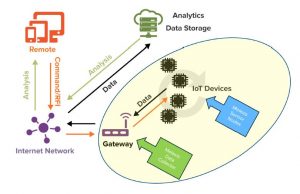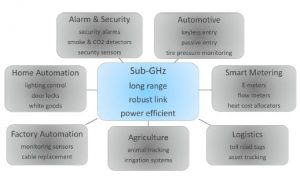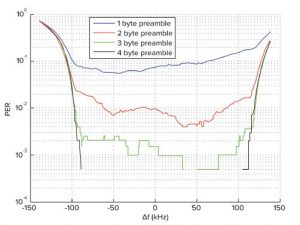The internet reached a major milestone a little over 10 years ago. Around 2004/5, according to Cisco, we reached the point that there was one device (‘thing’) per person on the planet connected to the internet. In fact, now, this global network has become known as the ‘Internet of Things’ (IoT). By now, it is estimated that there are between three and four internet-connected devices per person and this will almost double within the next three years, leading to around 26 billion devices on the IoT by 2020 (according to Gartner).
Although many organizations are investing a lot of resources, it is difficult to predict the size of the total IoT market. Early assumptions were forecasting more than 50 billion devices. Yet, a more realistic and recent forecast from ABI predicts a total 36 billion connected IoT devices by 2020. The ABI forecast anticipates 19 billion IoT nodes, 11 billion gateways and 6 billion mobile devices.
Future revenue potential for the IoT is even more difficult to estimate, due to the newness and rapid growth of the sector. The McKinsey Global Institute estimates somewhere between $4 trillion and $11 trillion in 2025.
Whatever the actual number of devices and associated revenue become, it is clear that the IoT is going to form a major part of the future.
When comparing the IoT to the ‘regular’ internet, it becomes obvious that a far greater proportion of activity on the IoT is machine-to-machine (M2M) communications. The information that travels on this network is mostly generated, interpreted, stored and acted upon without direct human intervention. Each of these uniquely identifiable embedded computing devices exists within the existing internet infrastructure and, when interconnected, will facilitate automation in nearly all aspects of daily life as well as enabling advanced applications of the future. Very soon, in fact by 2020, it is estimated that home devices such as white goods and HVAC systems will outnumber computers on the internet.
The rapid growth in applications is due to a combination of brand new product concepts (such as wearable fitness devices) and smart factories that are able to be controlled and monitored remotely as well as new spins on established technology – such as smart home applications (including automated lighting and heating controls). Innovators will continue to drive the IoT to create new applications – many that we are talking about already and, without doubt, some that have not even been thought of yet.
Yet, by definition, the IoT relies on communication for its very existence and with many devices, such as sensors, being placed remotely, wireless communication technologies are enabling the brave new world of the IoT.
IoT Ecosystem
As we see a strong trend of applications moving from wired to wireless, the whole radio spectrum is a valuable asset which is being used extensively. Availability of spectrum bandwidth becomes even more crucial to the evolution of localized wireless sensor networks (WSN) into the IoT. In the IoT space each connected device is a smart node that senses information and performs some form of signal processing and conditioning, either digital or analog. An example of this would be the filtering of valuable signals from noise in order to reduce the spectral bandwidth needed for data communications.
In commonly-used configurations, IoT sensor devices communicate with a gateway (or data collector) from which, data can be routed into the Internet to a centralized data storage that securely protects, stores and processes that information. Fig. 1 shows one potential representation of an IoT ecosystem where sensor data is remotely acted upon via the Internet. Melexis sensor and wireless products can be used in several applications here, both in the IoT sensor devices themselves and in the gateway that interfaces to the wider Internet.
Sub-GHz – Enabling greater distances
There is an industry-wide debate regarding whether to use a Sub-GHz or a 2.4GHz radio as the preferred carrier for all types of wireless data communication and sensing applications. Within the IoT infrastructure, 2.4GHz most often means Bluetooth-based technologies (often Bluetooth Low Energy – BLE) or Wi-Fi. Sub-GHz often refers to one of the ISM bands, for example at 433.92MHz or 868.3MHz.
A 2.4GHz based system offers a relatively high data throughput, often it is in the order of several Megabits-per-second (Mbps) for Wi-Fi and substantially less at around 260 kbps for BLE. Obviously, Wi-Fi is compatible to WLAN infrastructure such as routers and can therefore directly connect to the IoT. The various incarnations of Bluetooth can connect directly to a mobile device, which can then, in turn, provide a connection to the IoT / Internet. One downside of a 2.4GHz wireless link is its relatively short range (<10m) due to the high propagation losses that occur in comparison to Sub-GHz based systems.
Sub-GHz is an ideal choice for use if long range (up to 1km outdoors) is important to the application or installation. Sub-GHz provides high levels of robustness as well as excellent immunity against disturbing signals through the use of narrow-band radio channels (often around 25kHz). Furthermore, as Sub-GHz devices typically run on proprietary protocols, it is relatively easy to optimize them for power efficiency and long battery life; both essential for battery powered or energy-harvesting IoT remote sensors. Fig. 2 illustrates a number of IoT applications that benefit significantly from Sub-GHz technology.
Carrier frequency acceptance matters
An important element when using wireless links for any application, but especially IoT applications, is the ability for the receiving nodes to track carrier frequency deviations of the transmitting nodes. Modern integrated RF receivers and transmitters use quartz crystal technology for generating a local reference frequency within each device. Affordable crystals typically exhibit frequency stabilities in the range of ±10ppm to ±50ppm approximately. Less integrated RF products, which are often based on devices such as SAW resonators, are generally even less stable with tolerances of ±100ppm.
Classical RF analog transceivers and receivers are typically built with phase-coincidence demodulators. They will generally employ either an external discriminator circuit or an integrated FSK demodulator. As a result of the analog demodulation principle, these products offer a carrier frequency acceptance range of up to ±100kHz.
If we consider the carrier frequency of an IoT transmitter node of 868.3MHz based upon a low-cost crystal reference that has a tolerance of ±50ppm, the center frequency of the node can have a spread of about ±43kHz. This value may already exceed the FSK deviation, which is an essential modulation parameter. Typical allowable FSK deviation values for IoT sensor node applications are between ±10kHz to ±50kHz. Nevertheless, RF products with analog demodulators can cope with carrier frequency spreads that are larger than the FSK deviation due to their wide carrier frequency acceptance.
Modern highly integrated RF products perform the demodulation, and many other necessary signal conditioning operations, in the digital domain. This is possible due to modern semiconductor processes that are based on small geometries, thus leading to very compact IC designs. However, due to their digital nature, most modern RF transceivers exhibit relatively small carrier frequency acceptance ranges, compared to their legacy analog counterparts. Therefore, receiving a signal from an IoT sensor node can be a challenge for a digital RF receiver if the sensor node exhibits a poor frequency accuracy because of a wide tolerance crystal.
Melexis highly-integrated RF transceivers
The Melexis MLX73290-M modern RF transceiver provides a solution that works well with wide carrier frequency tolerances. Fig. 3 shows the block diagram of the MLX73290-M. As can be seen, a significant part of the device is digitally-based, this is shown in the grey-shaded box.
The MLX73290-M is a multi-channel RF transceiver IC that draws on the long-established technical expertise of Melexis in low power wireless implementation. Addressing the sub-GHz ISM bands from 300MHz through to 960MHz, the product delivers two RF channels, each with a programmable RF power transmitter (with power detectors) and a highly sensitive RF receiver. It is fully programmable via its serial peripheral interface (SPI).
This IC is highly suited to sub-GHz wireless applications like home/building automation, tire pressure monitoring (TPMS), automatic meter reading (AMR), alarm systems, passive keyless entry (PKE), medical diagnostics and telemetry. Its output power level ranges from -20dBm to 13dBm in 64 steps while its receiver sensitivity can attain -120dBm in a 15kHz bandwidth. With a maximum data rate of 250kbps, the transceiver is also capable of handling heightened data throughputs. Due to the high degree of programmability, engineers employing this IC are presented with plenty of scope when it comes to configuring and implementing an RF front-end. A wide variety of different RF parameters can be adjusted (number of channels, frequency resolution, output, frequency deviation, etc.), in order to satisfy specific application criteria. On-off keying (OOK), binary frequency shift keying (FSK), minimum shift keying (MSK), Gaussian minimum shift keying (GMSK) and Gaussian frequency shift keying (GFSK) modulation schemes are supported.
2 RF power detectors provide augmentation of radiated power performance during transmission. An energy harvesting interface allows battery-less power supply by using a solar cell in combination with a super capacitor. This accentuates the transceiver’s value in remote locations where power lines are impractical. Evaluation boards and software tools are also available.
The MLX73290-M is supplied in 5mm x 5mm 32-lead QFN package. It has an operational temperature range of -40°C to 105°C and operates from a supply voltage in the range 2.1 to 3.6V DC. The device includes a PLL synthesizer with 60Hz resolution, a 256byte FIFO that can be split 128/128 for RX/TX use and a total of 4 programmable GPIO ports for interfacing with other system elements.
With its carrier recovery feature the MLX73290-M transceiver is able to tolerate a carrier frequency deviation of up to twice the raw data rate (DR) usually expressed as ±2 x DR. The Carrier Frequency Acceptance Range (CFAR) is not dependant on the AFC setting. The AFC simply enables the carrier recovery to converge to a given value after each and every packet. This allows the preamble length to be reduced, if the application can tolerate losing a few packets at the start.
Fig. 4 illustrates the packet error rate (PER) against CFAR. The example here is given for a DR of 55.6kbps with a ±50kHz FSK deviation. As can be seen, there is a trade-off between the preamble length (which is the part of the packet during which the carrier recovery tries to converge) and the PER.
Conclusion
Undoubtedly, as the demand for IoT devices grows substantially, consumers and users will put manufacturers of these devices under price pressure, requiring them to reduce costs with each generation of product. This will inevitably lead to greater use of low-cost crystals with wider frequency tolerances in the sensor nodes to achieve this goal. As designers search for elegant solutions to this cost / performance trade-off, the MLX73290-M RF transceiver with its large carrier frequency acceptance range will become a popular solution for IoT data collectors as well as bidirectional network nodes.











